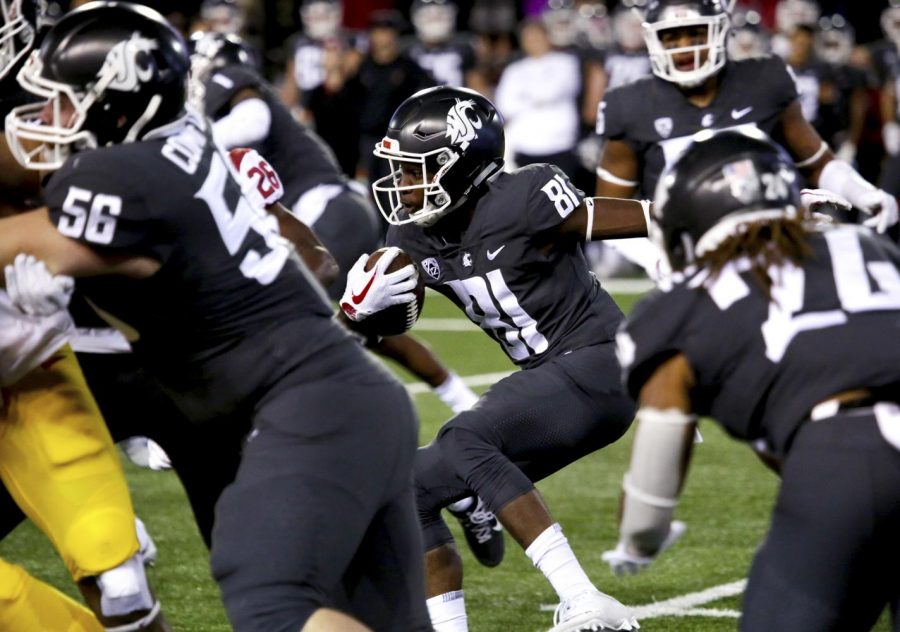Time for WSU to move on from Bill Moos
One columnist argues Moos’ departure was entirely expected
RYAN PUGH | Daily Evergreen file
Redshirt freshman wide receiver Renard Bell dodges offense vs. defense turmoil as he returns the kick off by USC on Sept. 29.
October 19, 2017
I think the monsoon of social media backlash directed at former WSU Athletic Director Bill Moos and WSU President Kirk Schulz is rooted in fear.
There’s a palpable sense that because Moos departed in the dark for the Nebraska cornfields, it automatically indicates the WSU football program will regress to its state during the Paul Wulff era. That, and the athletic department will cease to expand long overdue facility upgrades and fundraising efforts.
The paranoia around Pullman is speculative and feverish. Count me in, as a member of the camp that thinks Moos’ exit is hypocritical.
And really, Moos’ overnight maneuver should not surprise anyone. Give Moos his due credit for putting WSU football back on the national radar in the hiring of Head Coach Mike Leach, the construction of the Cougar Football Complex and his visibility at home football games. That being said, Moos’ entry and exit both were not without their fair share of baggage.
Let’s peel back the data a bit. Those upgrades to the football program largely contributed to the $50 million fiscal deficit the athletic department is saddled with.
“When someone is looking at another job or another position, they’re either running away from something or running to something,” Moos said at an introductory news conference on Sunday in Nebraska. “Believe me, I have nothing to run away from, but wholeheartedly wanted to run to this job.”
Sorry, not fully buying that one. Leaving Schulz and company with a pile of debt to address by 2021 suggests otherwise.
Moos “running away” to another job certainly has its historical roots as well. His relationship with Nike co-founder Phil Knight grew sour when he said he’d be interested in the athletic director job at University of Washington, while working in the same capacity at Oregon.
“Oregon got a new arena, I got a cattle ranch,” Moos said after he and Oregon parted ways in 2007.
That’s one way of looking at it. I just can’t imagine outwardly declaring interest in possibly making a lateral move to a rival university is going to prompt a major booster to fund the construction of a $227 million basketball arena.
Moos said when he took the vacant WSU Athletic Director job in 2010, he was saving his best for last at his dream job. The rhetoric at the time revolved around his goal of making WSU a destination job, not a stepping stone.
“It’s very heartwarming for me, because this is my alma mater,” Moos said in an interview with the Seattle Times in May 2010. “You know, the good Lord has ways of taking you where you need to be, if you just let him.”
Now, it all looks like a load of bologna. Moos said the Nebraska job is in the top echelon of posts an athletic director can take, so wouldn’t it appear as though he used his handiwork in revamping the WSU football program to springboard into a pay raise and destination job of his own?
John Blanchette of the Spokesman-Review lobbied the idea that the only sport, besides football, that noticeably improved and received national recognition under Moos was volleyball. Certainly, we can point to Moos’ second hiring of fourth-year WSU men’s basketball Head Coach Ernie Kent and the stagnation of the program as an obvious misfire at this stage.
Moos is noted by his colleagues and those who have worked with him as being straightforward and honest in all endeavors. Almost to a fault.
Leach referenced Moos’ rock-solid reputation at his news conference in the Cougar Football Complex on Monday.
“He’s the best AD that I’ve ever met,” he said. “Everything from active to retired to dead. Bill’s the best AD I’ve ever even met.”
In jumping over questions about Moos, it’s a good sign to see the head ball coach’s focus is on Saturday’s matchup with Colorado (4-3, 1-3) and that he thinks the team as a whole is motivated to improve.
Moos is gone. My message to everyone in and around Pullman is to get over it, because the writing was on the wall.
At his introductory news conference in Nebraska, Moos said that the job held his interest for the past 25 years. So really, coming out of retirement to helm WSU was never his pinnacle.
Maybe leading his alma mater 20-plus years ago following former Athletic Director Jim Livengood’s exit in 1994 was his ultimate goal, but that song became outdated a long time ago.
There has never been anything that has stopped Moos from jumping ship for a job that piqued his interest. In that sense, he quietly indicated that even at WSU, the same principle applied and that he’d walk if he saw fit.
And he just walked away.










